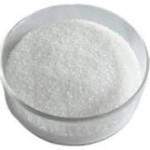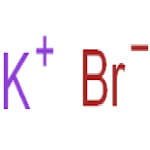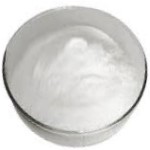Potassium Bromide USP BP Ph Eur Reagent Grade & Cream of Tartar or Potassium Bitartrate USP FCC Food Grade Suppliers Exporters, Manufacturers
Potassium Bromide
CAS Number: 7758-02-3 USP BP Ph Eur Reagent Grade Suppliers Exporters, Manufacturers

Please visit Safety Data Sheet of Potassium Bromide USP BP Ph Eur Reagent Grade Manufacturers.
Specifications of Potassium Bromide BP Ph Eur Grade
DEFINITION
Content: 98.0 per cent to 100.5 per cent (dried substance).
CHARACTERS
Appearance: White or almost white, crystalline powder or colourless crystals.
Solubility: Freely soluble in water and in glycerol, slightly soluble in alcohol.
IDENTIFICATION
A. It gives reaction of bromides.
B. Solution S (see Tests) gives the reactions of potassium.
TESTS
Solution S: Dissolve 10.0 g in carbon dioxide-free water R prepared from distilled water R and dilute to 100 ml with the same solvent.
Appearance of solution: Solution S is clear and colourless.
Acidity or alkalinity: To 10 ml of solution S add 0.1 ml of bromothymol blue solution R1. Not more than 0.5 ml of 0.01 M hydrochloric acid or 0.01 M sodium hydroxide is required to change the colour of the indicator.
Bromates: To 10 ml of solution S add 1 ml of starch solution R, 0.1 ml of a 100 g/l solution of potassium iodide and 0.25 ml of 0.5 M sulphuric acid and allow to stand protected from light for 5 min. No blue or violet colour develops.
Chlorides: Maximum 0.6 per cent.
Iodides: To 5 ml of solution S add 0.15 ml of ferric chloride solution and 2 ml of methylene chloride.
Shake and allow to separate. The lower layer is colourless.
Sulphates: Maximum 100 ppm.
Iron: Maximum 20 ppm.
Magnesium and alkaline-earth metals: Maximum 200 ppm, calculated as Ca.
Heavy metals: Maximum 10 ppm.
Loss on drying: Maximum 1.0 per cent, determined on 1.000 g by drying in an oven at 105C for 3h.
Specifications of Potassium Bromide USP Grade
KBr --- 119.0
Potassium Bromide contains not less than 98.0 percent and not more than 100.5 percent of KBr, calculated on the dried basis. It contains no added substances.
Appearance of solution: clear and colorless.
Test solution— Dissolve 10.0 g in carbon dioxide-free water, and dilute with the same solvent to 100 mL.
Identification:
A: A solution containing 4.5 mg of potassium bromide responds to the test for Bromide.
B: Responds to the test for Potassium.
Acidity or alkalinity: To 10 mL of the solution prepared for the test for Appearance of solution, add 0.1 mL of bromothymol blue TS: not more than 0.5 mL of 0.01 N hydrochloric acid or 0.01 N sodium hydroxide is required to change the color of this solution.
Loss on drying: Dry it at 100 to 105 for 3 hours: it loses not more than 1.0% of its weight.
Bromates:
Starch–mercuric iodide solution— Triturate 1.0 g of soluble starch with 5 mL of water and pour the mixture into 100 mL of boiling water, containing 10 mg of mercuric iodide.
Procedure— To 10 mL of the solution prepared for the test for Appearance of solution add 1 mL of Starch–mercuric iodide solution, 0.1 mL of a 100 g per L solution of potassium iodide, and 0.25 mL of 0.5 M sulfuric acid. Allow to stand protected from light for 5 minutes: no blue or violet color develops.
Limit of chlorine: not more than 0.6%.
Iodides: To 5 mL of the solution prepared for the test for Appearance of solution add 0.15 mL of a 10.5 g per 100 mL ferric chloride solution, and 2 mL of dichloromethane. Shake, and allow to separate. The lower layer is colorless.
Sulfates: A 2.0-g portion shows no more sulfate than corresponds to 0.2 mL of 0.020 N sulfuric acid (0.01%).
Limit of iron: not more than 20 ppm.
Magnesium and alkaline-earth metals: (0.02%, calculated as Ca).
Heavy metals: not more than 10 ppm.
Specifications of Potassium Bromide Analytical Reagent Grade
KBr
Formula Weight 119.00
CAS Number 7758-02-3
REQUIREMENTS
Assay: 99.0% KBr
pH of a 5% solution: 5.0-8.8 at 25C
MAXIMUM ALLOWABLE
Insoluble matter: 0.005%
Bromate (BrO3): 0.001%
Iodate (IO3): 0.001%
Chloride (Cl): 0.2%
Iodide (I): 0.001%
Nitrogen compounds (as N): 0.005%
Sulfate (SO4): 0.005%
Barium (Ba): 0.002%
Heavy metals (as Pb): 5 ppm
Iron (Fe): 5 ppm
Calcium (Ca): 0.002%
Magnesium (Mg): 0.001%
Sodium (Na): 0.02%.

Please visit Hazard Statement of Potassium Bromide USP BP Ph Eur Reagent Grade Suppliers.
Potassium Bitartrate
CAS Number: 868-14-4 Cream of Tartar USP FCC Food Grade Suppliers Exporters, Manufacturers

Please visit Safety Data Sheet of Cream of Tartar or Potassium Bitartrate USP FCC Food Grade Manufacturers.
Potassium Bitartrate USP Grade Specifications:
C4H5KO6 --- 188.18
Butanedioic acid 2,3-dihydroxy-, [R-(R*,R*)]-, monopotassium salt;
Potassium hydrogen tartrate CAS 868-14-4
DEFINITION
Potassium Bitartrate, dried at 105C for 3 h, contains NLT 99.0% and NMT 101.0% of C4H5KO6.
IDENTIFICATION
A. Ignite it: it leaves a residue that imparts a reddish-purple color to a nonluminous flame.
B. A saturated solution of it yields a yellowish orange precipitate with sodium cobaltinitrite.
C. Identification Tests - General, Tartrate: Meets the requirements.
ASSAY
Procedure
Sample: Dry 6 g of Potassium ;Bitartrate at 105C; for 3 h. Allow to cool, and weigh.
Analysis: Dissolve the Sample in 100 mL of boiling water, add a few drops of phenolphthalein and titrate with 1 N sodium hydroxide to a pink endpoint. Perform a blank determination. Each mL of 1 N sodium hydroxide is equivalent to 188.2 mg of C4H5KO6.
Acceptance criteria: 99.0% to 101.0% on the previously dried basis
Sample: 500 mg
Analysis: Mix the Sample with 3 mL of 6 N ammonium hydroxide.
Acceptance criteria: No undissolved residue remains.
Limit of Ammonia:
Sodium hypochlorite solution: Use a commercially available solution that contains 4.0% to 6.0% of sodium hypochlorite.
Oxidizing solution: [Note: Prepare on the day of use.] Alkaline sodium citrate and Sodium hypochlorite solution (4:1)
Diluted sodium nitroferricyanide solution: Sodium nitroferricyanide and water (1:10)
Standard stock solution: Dry 300 mg of ammonium chloride over silica gel for 4 h, and use it to prepare a 0.3 mg/mL solution in water. This solution contains 100 µg/mL of ammonia.
Standard solution: 0.25 µg/mL of ammonia in water, from Standard stock solution
Sample solution: 2.5 mg/mL of Potassium Bitartrate in water. Heat gently to facilitate the dissolution.
Analysis
[Note: Carefully follow the order of addition stated below.]
Separately transfer 6.0 mL each of the Standard solution and the Sample solution to two color-comparison tubes. To each tube add 0.4 mL of phenol, 0.4 mL of Diluted sodium nitroferricyanide solution, and 1.0 mL of Oxidizing solution. Dilute with water to 10 mL, mix, and allow to stand for 1 h.
Acceptance criteria: The color of the Sample solution is not darker than the color of the Standard solution (NMT 0.01%).
Packaging and Storage: Preserve in tight containers.
Specifications of Potassium Acid Tartrate FCC Food Grade
Potassium Bitartrate; Cream of Tartar
KOOCCH(OH)CH(OH)COOH
C4H5KO6 Formula wt 188.18
INS: 336 CAS: 868-14-4
DESCRIPTION
Potassium Acid Tartrate occurs as colorless or slightly opaque crystals, or as a white, crystalline powder. It is a salt of L(+)- tartaric acid. One gram dissolves in 165 mL of water at 25C, in 16 mL of boiling water, and in 8820 mL of alcohol. A saturated solution is acid to litmus.
Function: Acidifier; buffer.
REQUIREMENTS
Identification:
A. When sufficiently heated, a sample chars and emits flammable vapors having an odor resembling that of burning sugar. At a higher temperature and with free access to air, the heat consumes the carbon of the black residue, and a white, fused mass of potassium carbonate remains that imparts a red-purple color to a non-luminous flame.
B. Mix a saturated solution of sample with sodium cobalt nitrite TS. A yellow-orange precipitate forms.
C. Neutralize a saturated solution of sample with 1 N sodium hydroxide in a test tube, add silver nitrate TS, then just sufficient 6 N ammonium hydroxide to dissolve the white precipitate, and boil the solution. A mirror forms on the inner surface of the test tube from the silver deposited there.
Assay: Not less than 99.0% and not more than 101.0% of C4H5KO6 after drying.
Ammonia: Passes test.
Insoluble Matter: Passes test.
Lead: Not more than 2 mg/kg.

Please visit Hazard Statement of Cream of Tartar or Potassium Bitartrate USP FCC Food Grade Suppliers.
Potassium Bromide CAS Number 7758-02-3 & Cream of Tartar or Potassium Bitartrate CAS Number 868-14-4 Supplier Exporter, Manufacturer:
Annie Chemie P Ltd
Mumbai 4000010, INDIA
With Agents and offices in UAE, USA, Europe.
e-mail: info@anniechemie.com
Copyright and Usual Disclaimer is Applicable.
June 1, 2025
Exporters to USA, Canada, UK, Europe, UAE, Nigeria, Algeria, Turkey, Mexico, Brazil, Chile, Argentina, Australia, Dubai etc.
Perfection is made up of small things and that is a big thing.
